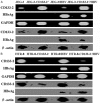Effect of hepatitis B virus infection on trophoblast cell line (HTR-8/SVneo) and choriocarcinoma cell line (JEG3) is linked to CD133-2 (AC141) expression
- PMID: 27508045
- PMCID: PMC4969461
Effect of hepatitis B virus infection on trophoblast cell line (HTR-8/SVneo) and choriocarcinoma cell line (JEG3) is linked to CD133-2 (AC141) expression
Abstract
Mother-to-infant transmission of hepatitis B virus (HBV) plays an important role in the chronic carrier state in China. In our studies, the response of trophoblast cell and choriocarcinoma cell to HBV infection regarding the expression of CD133-2 (AC141) was evaluated. Western blot and RT-PCR showed that a high level of CD133-2 protein and mRNA in HTR-8/SVneo cells, but a low level in JEG-3 cells. Lower proliferation and mobility, and higher apoptosis were observed in HTR-8/SVneo cells and JEG-3-CD133-2(+) cells after HBV infection than those in HTR-8-CD133-2(-) cells and JEG-3 cells. Our main finding is that CD133-negative cells (HTR-8-CD133-2(-) and JEG-3) are prone to HBV infection. In the last, our data indicated that the activation of Smad signaling pathway and the induction of epithelial-mesenchymal transition (EMT) in CD133-negative cells after HBV infection. In summary, our study demonstrated that CD133 is a key factor that mediated HBV infection to trophoblast cell and choriocarcinoma cell.
Keywords: HBV infection; Smad pathway; choriocarcinoma; mobility; trophoblast.
Figures



References
-
- Yin Y, Wu L, Zhang J, Zhou J, Zhang P, Hou H. Identification of risk factors associated with immunoprophylaxis failure to prevent the vertical transmission of hepatitis B virus. J Infect. 2013;66:447–452. - PubMed
-
- Hanna N, Hanna I, Hleb M, Wagner E, Dougherty J, Balkundi D, Padbury J, Sharma S. Gestational age-dependent expression of IL-10 and its receptor in human placental tissues and isolated cytotrophoblasts. J Immunol. 2000;164:5721–5728. - PubMed
LinkOut - more resources
Full Text Sources
Research Materials
